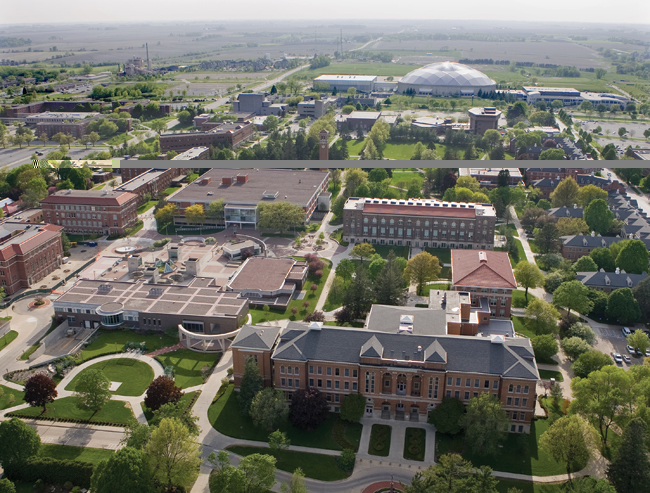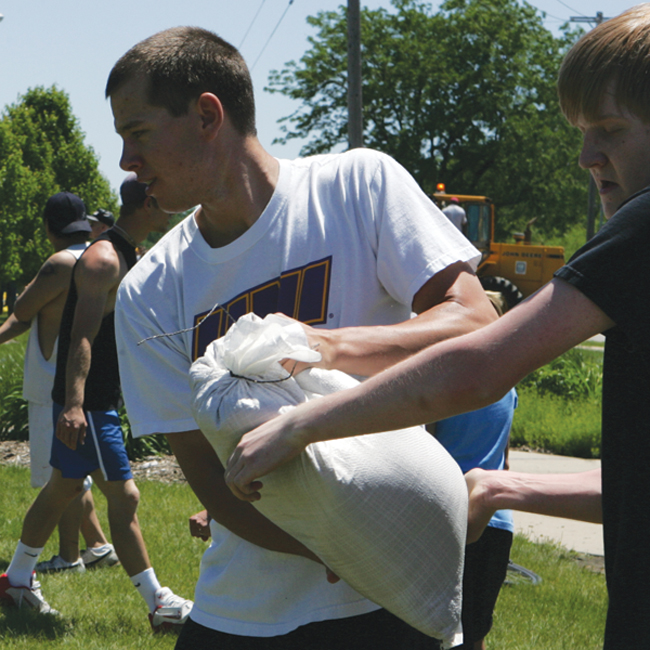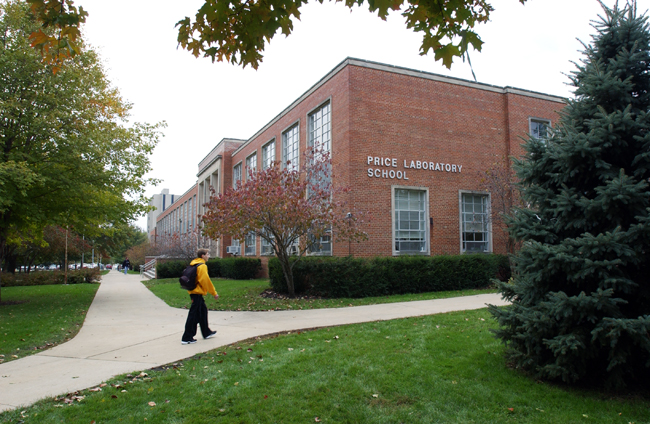Introduction to the University
The University of Northern Iowa (UNI) has undergone a number of transformations as an institution of higher learning from its start as a state normal school to its current status as a comprehensive university. However, as much as the University has changed in the 134 years of its existence, its core values have remained constant. The institution has always been characterized by its commitments to academic excellence; to elementary and secondary education in the state of Iowa; to fostering a personalized learning environment with close ties among students, faculty and staff; to creating a welcoming and equitable environment for all its members; and to serving the broader community of which it is a part. Today these commitments remain central to the University. They have been articulated by current UNI President Benjamin Allen in his three priorities for the University: to be known as the leading undergraduate institution in the State; to be known as a leader in pre-K–12 issues; and to enhance the economic, social, and cultural development of the State.
Back to Top
History of UNI
The University of Northern Iowa traces its origins to the Iowa State Normal School, founded in 1876 as a teacher-training institution. In 1904 the Normal School was authorized to offer a four-year college curriculum culminating in the Bachelor of Arts in Education degree. The Iowa General Assembly acknowledged this shift in purpose in 1909, voting to rename the school the Iowa State Teachers College.[1] It remained a teacher’s college until 1961, when it became the State College of Iowa and began offering the Bachelor of Arts degree to students without teacher certification. In 1967, the College adopted its current title: the University of Northern Iowa. With this new designation came a charge to “offer undergraduate and graduate courses … conduct research and provide extension and other public services … to facilitate the social, cultural and economic development of Iowa.” The University retained the “primary responsibility” of preparing teachers and other educational personnel for schools, colleges and universities, but it was now also directed to “carry out research, and provide consultative and other services for the improvement of education throughout the state.”[2] By 2000, UNI had more than 110 undergraduate programs and 50 graduate programs in education, business and the liberal arts and sciences, an impressive and modern campus, numerous community outreach programs, and rising student enrollment, with an increase in faculty that kept the faculty-student ratio steady at 1:16. [3]
Back to Top
UNI’s Accreditation History
The University of Northern Iowa is accredited through the doctoral degree (Doctorate of Education and Doctorate of Industrial Technology) by The Higher Learning Commission (HLC), North Central Association of Colleges and Schools (NCA). UNI was first accredited as a teacher training institution in 1913 and has been continuously accredited as a four-year institution since 1930. It was first granted approval to offer undergraduate liberal arts non-teaching degrees in 1961. It was granted approval to offer programs at the Master’s level in 1951 and the Doctoral level in 1978. The last comprehensive NCA evaluation took place in 2000-2001, at which time the next comprehensive review was set for 2010-2011, with a progress report on UNI’s general education program and assessment due in October 2004. That report proved acceptable to the Commission staff.[4]
See Appendix B, Federal Compliance, section VII for specialized accreditations.
Back to Top
UNI and Higher Education in Iowa
The University of Northern Iowa is one of three public universities governed by the Board of Regents, State of Iowa, as specified in Chapter 262 of the Code of Iowa. The Board also oversees two other state institutions, the Iowa School for the Deaf and the Iowa Braille and Sight Saving School. The Board consists of nine members appointed to staggered six-year terms by the Governor and subject to Senate confirmation.[5] There must be gender balance on the Board and no more than five members of the same political party. One member must be a full-time student enrolled at either the graduate or undergraduate level at one of the state universities. The Board convenes the representatives of the central administrative units of the Regent institutions at least four times each year (eight meetings are scheduled for 2010) at one of the Regent institutions. The proceedings of the Board's monthly meetings are formalized in the General Docket (a public document), which serves as the Board's agenda and chronicles the major issues. Meeting minutes serve as the official record of the actions of the Board.[6]
The Board establishes the missions, adopts strategic plans, makes educational policy, appoints presidents and other institutional officials, reviews and approves budgets for submission to the Governor and General Assembly, establishes and oversees annual operating budgets and personnel policies, pursues public policy and budget priorities, reviews and approves academic programs, and adjudicates disputes at the University of Northern Iowa and the other Regent institutions.[7] According to the 2004-2009 Board of Regents Strategic Plan, “the Board of Regents governs and coordinates the activities of Iowa's three public universities and two special schools; advocates for and exercises responsible stewardship of resources; engages capable presidents and superintendents to ensure that the institutions apply knowledge to benefit Iowans; and communicates the positive impact and value of the Regent institutions to the state, its citizens and society.” The Board expects the Regent institutions, in accordance with their respective missions, to “provide a high-quality accessible education to all students, in concert with Iowa’s other educational entities; engage in high-quality research, scholarship, and creative activities to enhance the quality of life for Iowans and society in general; provide needed public services; and support economic development in partnership with public and private sectors.”[8]
The Board Office is responsible for preparing the docket and records of Board actions, commissioning reports, charging committees to study issues, providing staff assistance to the Board, reviewing and analyzing institutional proposals, and preparing recommendations to the Board. The Board Office, which apprises the Regent institutions of national trends and issues, is located in Des Moines and is headed by an executive director. At the University of Northern Iowa, the Special Assistant to the President for Board and Governmental Relations submits institutional requests and materials to the Board Office for the Regent meetings and responds to inquiries from the Board Office.
Board members are accessible to all constituencies on and off campus. Moreover, the university presidents are authorized and encouraged to utilize appropriate faculty, students, and staff representatives as institutional resource persons at each Board meeting. Students, faculty, and staff may request an opportunity to appear before the Board to discuss matters of interest and may request that an item be included on the docket. The Board is also accessible through UNI's Web site.[9]
Back to Top
Overview and Brief Description of the University Since 2000
Located on a 910-acre campus with 57 buildings, UNI has an enrollment of 13,080: 11,294 undergraduate and 1,786 graduate students. Of the University’s 1,846 employees, 810 are faculty members who instruct students in the 33 academic departments of the five undergraduate colleges (Business Administration, Education, Humanities and Fine Arts, Natural Sciences, and Social and Behavioral Sciences) and one graduate college. The campus has nine residence halls with capacity for 4,174 students.[10]
See Appendix C for Institutional Snapshot.
As noted in the introduction to the self-study, since 2000 the University of Northern Iowa has experienced a variety of changes: in strategic planning, senior leadership, organizational structure, and financial climate. The biggest challenges of the decade have been dealing with the budget cuts that accompanied the recessions of 2001-2003 and the recession that began in fall 2008. In these challenging times, the University has done its best to stay focused on its core mission. In the past four years, it has worked hard to uphold President Allen’s priorities: to be known as the leading undergraduate institution in Iowa; to be known as a leader in state pre-K through 12 issues, and to enhance the economic, social, and cultural development of the state. The following section provides some highlights from the past decade on these three priorities.
Priority One: Be known as a leading undergraduate institution
The University has garnered national recognition for the quality of its programs in the years since 2000. In a national report released in 2004 by the Education Trust, UNI was singled out for having the highest graduation rate among its peer institutions. The six-year graduation rate for the 2003 cohort remains high at 66.5%. The report referred to UNI as a model of effective practice.[11] In 2009, UNI was ranked second in the “Best Midwest Universities—Master’s” category for public universities, by U.S. News & World Report for the 13th consecutive year.[12] UNI was named one of a group of 158 colleges on the Princeton Review's list of “Best in the Midwest” for 2010.[13]
Priority Two: Be known as a leader in Pre-K through 12 issues
UNI’s Price Laboratory School (PLS) was designated an Iowa State School of Character in 2007 and 2008. In 2009, PLS became the first statewide Research & Development (R&D) School. “The R&D school, a collaboration among UNI, the University of Iowa, Iowa State University and the Iowa Department of Education, aims to raise and sustain the level of all Iowa pre-K–12 students’ educational attainment and personal development, enhance the preparation and professional competence of Iowa educators, and focus on research to meet Iowa’s changing educational needs.”[14]
UNI provides the leadership for the Iowa Math and Science Education Partnership (IMSEP), which was spearheaded by President Allen. IMSEP is a response to Iowa’s shortage of qualified math and science educators and falling levels of student achievement. It is a collaborative effort among the University of Northern Iowa, the University of Iowa, and Iowa State University. IMSEP has received $3.6 million in state appropriations to implement programs across the State to achieve three goals: improve math and science performance of Iowa students, prepare more high-quality math and science teachers for Iowa’s schools, and promote statewide collaboration and cooperation.[15]
Priority Three: Enhance the economic, social and cultural development of the state
While the University has always been involved in outreach to address critical state needs, a number of efforts in the last decade further strengthened this commitment. The University was recognized for the value of these efforts in 2006, when it became one of 62 universities to be granted a new elective Carnegie classification—Community Engagement: Curricular Engagement and Outreach and Partnerships.[16]
UNI’s outreach activities are extensive and diverse. For example, in 2003 President Koob helped found the Greater Cedar Valley Alliance, an economic development group serving the cities of Cedar Falls and Waterloo and surrounding communities.[17] In fall 2005, the University created a new program, Lifelong University, to offer non-credit courses to members of the community at very low fees ($15-$40 per course in spring 2009).[18] The new Human Performance Center, completed in May 2008, also supports the University’s effort to serve the community by providing medical and other services, as well as supporting experimental and academic learning.  Business and Community Services (BCS) also provides a myriad of outreach programs and activities that enhance the economic, social, and cultural development of the state through its 15 programs.[19]
Business and Community Services (BCS) also provides a myriad of outreach programs and activities that enhance the economic, social, and cultural development of the state through its 15 programs.[19]
In the area of environment and sustainability, the University has worked hard in the last ten years to enhance the economic, social, and cultural development of the state by addressing critical needs. The University has expanded existing initiatives, such as the Buy Fresh/Buy Local program. The UNI recycling program has also made great strides in the same period, and it received the Iowa Recycling Association Best School Recycling Program Award in 2007.[20] UNI has recently received national recognition for these sustainability efforts. It was selected in 2010 for inclusion in The Princeton Review’s Guide to 286 Green Colleges. This new guidebook only focuses on “colleges and universities that have demonstrated an above average commitment to sustainability activities and initiatives.”[21]
 UNI’s commitment to the community was also demonstrated in spring 2008 as tornadoes and record flooding devastated much of eastern Iowa, including the Cedar Falls area. Dancer Hall and Bender Hall were designated Disaster Recovery Centers by the Iowa Homeland Security and Emergency Management Division as well as the Federal Emergency Management Agency. The West Gymnasium was also opened as a Red Cross shelter for individuals affected by the severe storms, tornadoes, and flooding of the Cedar River in Cedar Falls and Waterloo.[22]
UNI’s commitment to the community was also demonstrated in spring 2008 as tornadoes and record flooding devastated much of eastern Iowa, including the Cedar Falls area. Dancer Hall and Bender Hall were designated Disaster Recovery Centers by the Iowa Homeland Security and Emergency Management Division as well as the Federal Emergency Management Agency. The West Gymnasium was also opened as a Red Cross shelter for individuals affected by the severe storms, tornadoes, and flooding of the Cedar River in Cedar Falls and Waterloo.[22]
While the last decade has presented resource challenges to the University, upholding commitment to students and the citizens of the state has been a priority. Maintaining this commitment will continue to be an institutional focus.
Back to Top
Overview of UNI’s Self-Study Process
UNI conducted a special-emphasis self-study, by participating in the Foundations of Excellence® program (FoE) as specified in the joint project between the Higher Learning Commission (HLC) and the Policy Center on the First Year of College. The application requirements for the joint project are specified on the HLC Web site. To be eligible to participate in this customized self-study, UNI first had to apply and then be approved by the Policy Center to participate in the FoE program and by the Commission to conduct the customized self-study. The University was given final approval by the HLC in May 2008.[23]
Because a specialized self-study is more complex than a standard HLC self-study, the process is also more complex. This self-study report addresses all of the HLC’s self-study requirements including the five HLC criteria for accreditation and the nine FoE Dimensions (philosophy; organization; learning; faculty; transitions; all students; diversity; roles and purposes; and improvement). For this reason, two separate but overlapping groups were created to work on the self-study: the HLC steering committee (and its subcommittees) as well as the campus FoE steering committee (and its subcommittees). This self-study contains a chapter for each of the five HLC criteria and each of the nine FoE Dimensions.
In fall 2007 and early spring 2008, upper-level administrators identified key campus leaders to chair and to serve on the HLC steering committee and to chair the FoE steering committee. These leaders were chosen, as the Commission suggests, for their experience, visibility on campus, credibility, and ability to think broadly about the University. President Allen and upper-level administrators fully supported the reaccreditation work and helped to highlight its importance in a campus-wide Town Hall meeting in March 2008. They also provided the funding necessary for the HLC accreditation work and participation in Foundations of Excellence®.
To ensure an inclusive and open self-study process, steering committee leaders made public calls for faculty, staff, and student volunteers to serve on the subcommittees in May and September of 2008. In addition, the Self-Study Coordinator spoke about accreditation, FoE, and opportunities for volunteers with a number of campus groups, including the Northern Iowa Student Government (NISG), the NISG Freshman Council, the Student Affairs directors, the University Faculty Senate, the President’s staff, the UNI Foundation staff, Administration and Financial Services directors, the Academic Affairs Council, merit staff, professional and scientific staff, all department heads, and all college senates. Faculty and staff were also asked for names of students they would recommend to serve on the subcommittees. The result of these efforts is that the membership of the HLC and FoE subcommittees includes over two hundred faculty, staff, and students and represents a broad cross-section of the campus community. See Appendix D for a list of all committee members. The timeline below provides specific details on the process and the timetable for the project.
Figure 1.1 Self-Study General Timeline
| Month | Description |
|---|---|
| Fall 2007 | Meetings held with Academic Affairs and Educational & Student Services to discuss participation in the FoE program. |
| January 30, 2008 | Conference call with Dr. John Gardner, Director of the FoE. |
| February 6, 2008 | University Council meeting to discuss Reaccreditation and FoE. |
| February 14, 2008 | HLC Steering Committee convened to begin self-study process. Accreditation Web site launched. |
| February 22, 2008 | UNI formally admitted to the FoE program. |
| March 5, 2008 | Town Hall Meeting to discuss Reaccreditation and FoE. |
| April 7, 2008 | Conference call with Dr. John Gardner, Director of the FoE. |
| April 12-15, 2008 | HLC Steering Committee members attend HLC Annual Meeting. |
| Spring 2008 | HLC Steering Committee plans self-study process and organization of subcommittees. |
| May 2008 | HLC Criteria Subcommittees appointed. |
| May 2008-April 2009 | Subcommittees collect, analyze, and interpret data and draft reports. |
| July 31-August 1, 2008 | Team attends FoE Launch Meeting. |
| August 2008 | FoE Dimension Subcommittees appointed. |
| September 2008 | FoE Task Force convened and Current Practices Inventory initiated. |
| October 2008 | FoE faculty/staff surveys administered. |
| October 7, 2008 | Campus Launch Meeting. HLC Liaison visits campus. |
| October 31, 2008 | All subcommittee work plans due to steering committee. |
| November 2008 | FoE first-year student survey administered. |
| November 2008-May 2009 | FoE Task Force analyzes data and develops draft reports and strategic action plan. |
| February 6, 2009 | Team attends FoE Winter Meeting. |
| April 2009 | HLC Steering Committee members attend HLC Annual Meeting. |
| May 6, 2009 | Draft reports from all subcommittees due to HLC Steering Committee. |
| May-August 2009 | FoE Strategic Action Plan refined. |
| September 2009 | FoE Strategic Action Plan initiated. |
| October 1, 2009 | Final reports from subcommittees due to HLC Steering Committee. |
| October-November 2009 | Editing committee revises self-study draft. |
| December 2009 | UMPR finalizes self-study draft. |
| January-February 2010 | Campus input regarding self-study draft. |
| March-June 4, 2010 | Self-study refined based on input from campus and outside reader. |
| April 2010 | Steering Committee members attend HLC Annual Meeting. |
| June 7, 2010 | Full, approved text and visuals to UMPR. |
| June 7-August 2, 2010 | Self-study print and Web production. |
| July 2010 | Seek public comments – submitted directly to HLC. |
| August 2, 2010 | Completed files to printer and electronics vendors. |
| September 1, 2010 | Distribution of self-study to HLC review team. |
| November 8-10, 2010 | HLC review team visits campus. |
| February 2011 | Convene Steering Committee to develop program plan to address the recommendations from the self-study and the HLC review team. |
| November 2012 | Annual Report on the progress in implementing the FoE Strategic Action Plan and self-study recommendations. |
| November 2013 | Annual Report on the progress in implementing the FoE Strategic Action Plan and self-study recommendations. |
Participation in a special-emphasis self-study essentially has required the University to conduct two separate but integrated self studies at the same time. In view of the overlap among chapters, the HLC and FoE steering committees coordinated their work so the final self-study reflects an integrated process. Accordingly, there is significant overlap between membership of the FoE steering committee and the HLC steering committee, and the two groups maintained close and constant communication.
To ensure that work on the self-study proceeded as smoothly and as transparently as possible, the accreditation team set up a reaccreditation Web site[24] to enhance communication and to provide a variety of accreditation resources for committee members and the campus as a whole. It also created a campus-specific FoE Web site to keep the campus apprised of the FoE process. In addition, a data collection committee and a SharePoint Web site were established. The data collection committee collected data for all other committees and then posted that information on the SharePoint site, where it was visible to all subcommittees. The FoE steering committee was able to rely on the Policy Center for specific guidance on the work its subcommittees performed and to receive technical support for the FoE technology platform, FoEtec®, for recording data, and for internal and external communication, as well as reporting findings.
Since UNI is an institution that prides itself in putting “Students First,” the accreditation team tried to maximize student involvement in all phases of our self-study. It offered two credit-course options for participating students, including an independent study course, University Reaccreditation & Foundations of Excellence® and the Leadership Practicum: Reaccreditation & Foundations of Excellence®. It also involved undergraduate research methods students in the analysis and presentation of FoE survey data, thus turning this process into an applied research opportunity for our students. The Honors Program, in addition to contributing a number of student volunteers to the process, also helped publicize and increase participation in the FoE student survey.
The committees also developed strategies to ensure the whole campus would remain focused on reaccreditation throughout the entire process. UNI’s Marketing & Public Relations office developed a marketing plan to notify campus constituencies of milestones and to invite participation as appropriate. A campus-wide Launch Meeting was held in October 2008 to explain the HLC accreditation process and the role of the FoE program in this process, to put a personal face on accreditation, and to highlight UNI’s commitment to a truly meaningful institutional evaluation. At that meeting all HLC and FoE committee members were introduced to the attendees, and they were available for questions. UNI’s President and our HLC Staff Liaison addressed the audience, and our Policy Center Liaisons were involved through a live Web link. The accreditation team continued its efforts to involve the University community throughout the entire self-study process. For example, it sent updates on UNI’s accreditation efforts to the entire University community on a regular basis and held public input meetings to discuss drafts of portions of the self-study as they were completed.[25]
The end result of this self-study process is a report in which the whole University community shares ownership. This is of key importance since UNI chose a special-emphasis self-study to examine the ways the University approaches the first year of college and to discover how it could improve in that area. By improving students’ experience in the first year, the University hopes to create a more solid foundation for the entire undergraduate experience. In order for this to happen, the self-study must be a document which the University community reads and sees as its own blueprint for the future.
Back to Top
Structure of the Self-Study Report
This self-study report is organized into five parts including appendices. Part One includes this chapter and another describing in detail UNI’s response to the 2001 Team Evaluation Report and UNI’s progress since 2001. Part Two contains chapters on each of the five HLC accreditation criteria. Part Three consists of chapters on each of the nine Foundations of Excellence® Dimensions. Part Four offers conclusions and Part Five contains the appendices.

